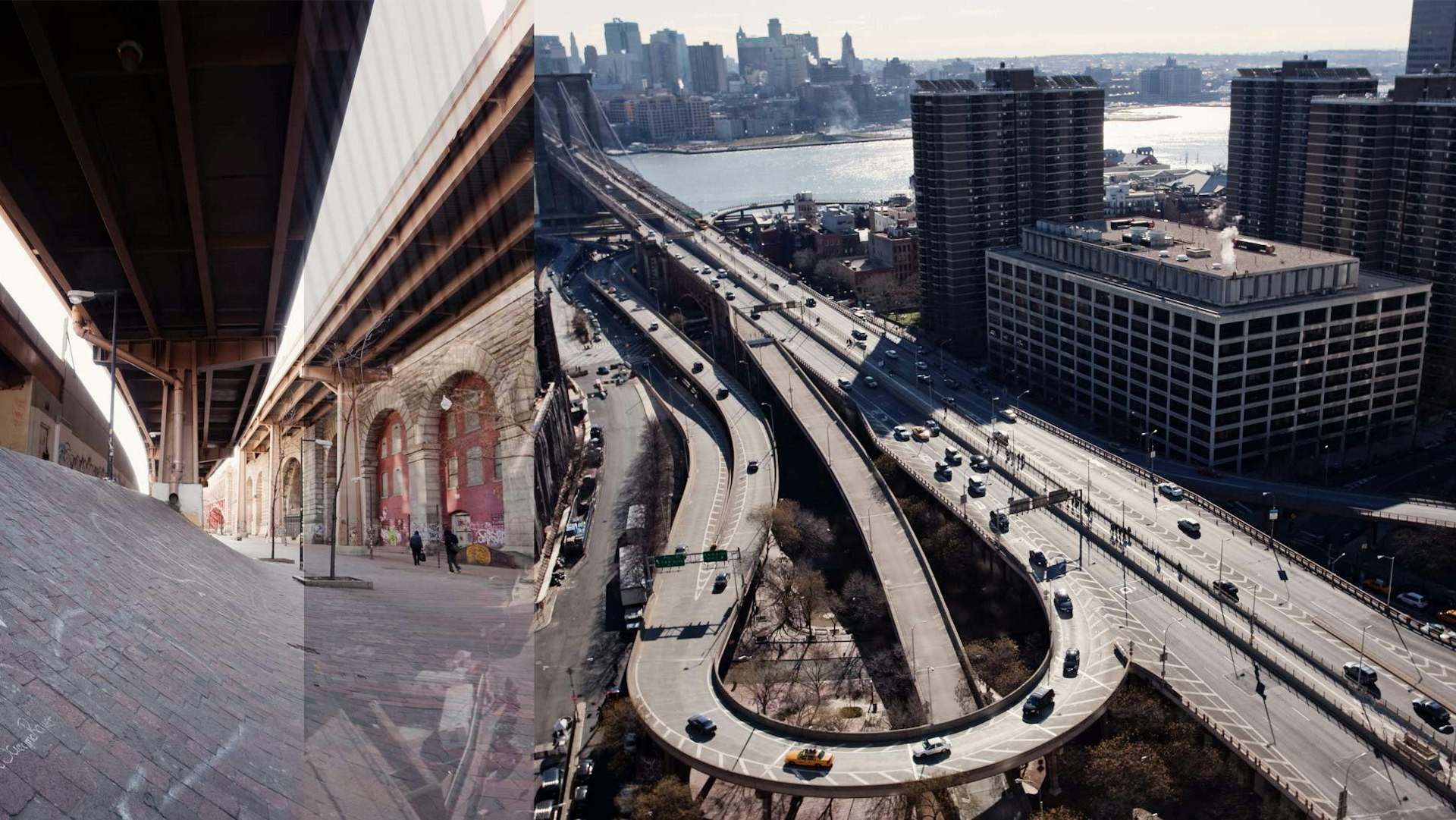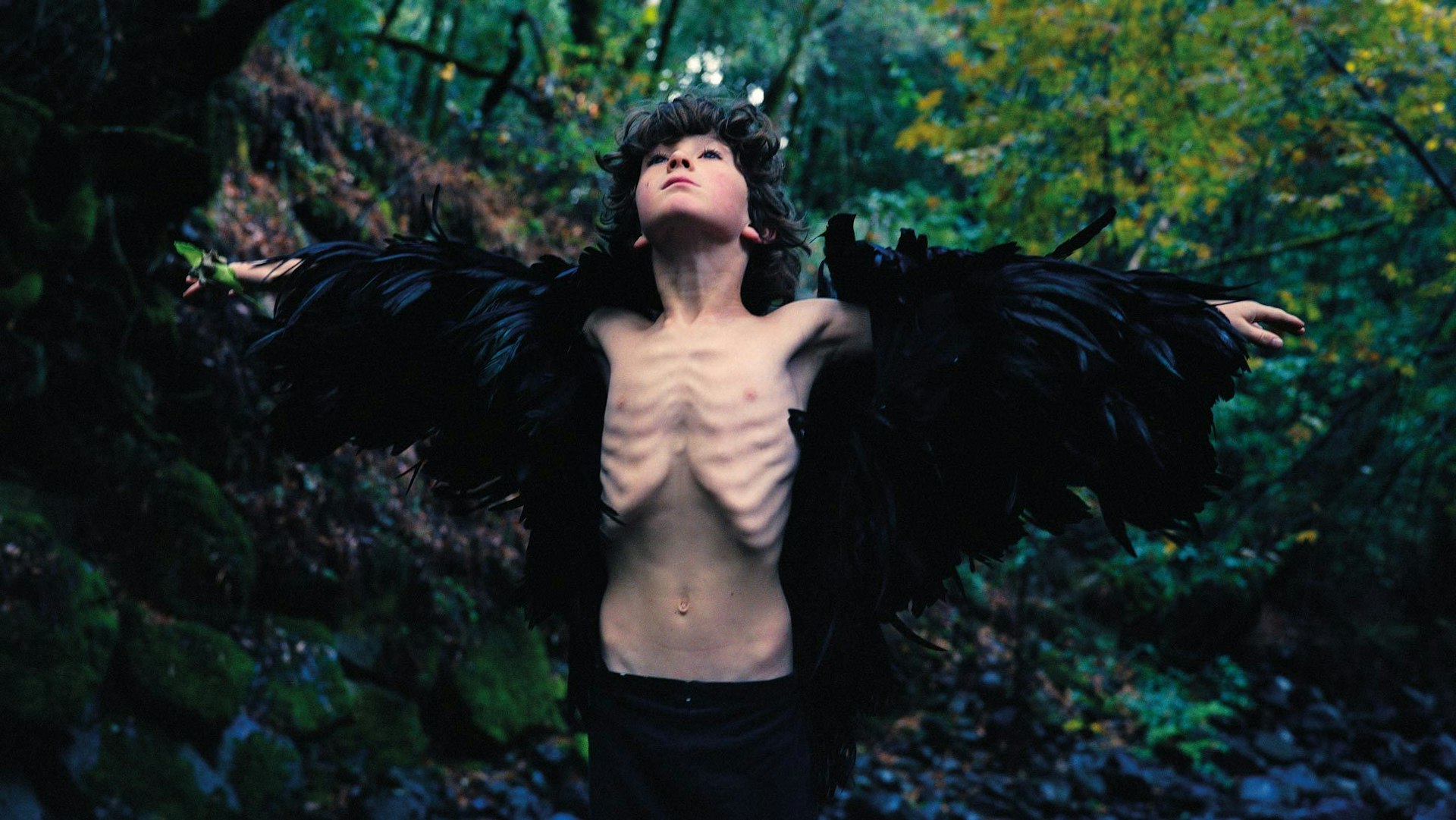
Brooklyn Banks
- Text by Tetsuhiko Endo
- Photography by Brett Beyer
Brooklyn Bridge is one of America’s most iconic structures. Built in 1883, it has come to represent the aspirations of generations of Americans. But what you can’t see in the legions of pictures, TV shows and movies in which it appears, is that it is also home to one of skateboarding’s most legendary landmarks, the Brooklyn Banks. Nestled beside the bridge’s giant struts, the Banks have been a Mecca for New York City’s skaters for thirty-seven years.
There are two great ironies about the Banks. For starters, they aren’t in Brooklyn. They are on the Manhattan side of the bridge in an area that was residential for most of New York City’s history. In 1969, city engineers, as they tend to do in New York, wiped half a city block off the map to construct two giant off-ramps for the bridge. It was in the deep shadows of these ramps that the banks were built, as part of a larger development project, in 1973. And therein lies our second irony: the other part of that project was 1 Police Plaza, the newly constructed headquarters for the New York City Police Department. Despite (or perhaps in spite of) the police presence, New York’s skate community found a home at the Banks, claiming it as their own in the mid-eighties, and nurturing it into the stuff of legend throughout the nineties. Although the Upper Banks were lost to renovation in 2004, local skaters fought to preserve the Lower Banks, and even got the city to add rails and ledges to the spot.
But in this great, dirty, bedlam of a city, where memories only go back as far as the last pay-cheque (and even then it depends on the size of the cheque), the Banks were never going to be safe forever. In late 2009, the New York City Department of Transportation decided to close the Banks, from early 2010 until 2014, as part of a project to refurbish Brooklyn Bridge. Although part of the area is scheduled to re-open this summer, the use of the space as a storage area will render it all but unrideable until the entire project is completed. As this goes to print, the future of the Banks is still being debated between city officials and the skaters who have once again rallied to protect their home turf. One thing is certain: skateable or not, the Banks have earned a place in the pantheon of locales, like Pipeline and Chad’s Gap, that command as much respect as the riders who frequent them.
But how does urban wasteland become hallowed ground?
It begins with accessibility. Anyone who has ever pushed wood in New York will tell you that the location of the Banks is their greatest asset. Standing among the titanic steel columns of the off-ramps, it’s easy to see why. They’re an anomaly: two blocks of municipal nothing where the puzzle pieces of unrestrained urban development simply don’t fit together. When skaters first stumbled upon them, they discovered one of the few public spaces in the history of Manhattan that was always rideable, simply because, as Steve Rodriguez, owner of skate company 5boronyc, says, “They weren’t friendly for anything.”
“It was dirty – I mean, really dirty,” adds Shut Skateboards founder Rodney Smith, recalling his first encounter of the Banks in the eighties. “Crack vials everywhere, homeless people, homes actually built along the side of the bridge… I even remember one guy had a TV rigged to the power source in a light post.”
In the ever-changing urban landscape, the Banks became a haven for anyone wanting to simply push around: no one was trying to kick them out and the spot wasn’t likely to change. Even the NYPD were happy with the arrangement – if the kids were in the Banks, they weren’t bothering anyone, right?
But location means nothing without inspiration, and that’s where the red bricks come in. The Banks are made up of hundreds of thousands of them, precisely arranged into great ochre waves, smoother and prettier than any caught on the beaches of Long Island. Landscape architect M. Paul Friedberg created them, but even he couldn’t predict that they would become so much more than just a pile of bricks. “So kids like to skateboard there now?” he chuckles. “It certainly wasn’t designed with skating in mind… I don’t have a rationale when I design. So much of it is intuitive, like Stravinsky said, ‘It’s not premeditated, it’s all trial and error.’”
And that’s a pretty good description of the way his creations are ridden. “The imperfection of the Banks is what makes them perfect for skaters,” says Smith. “By not being made for skateboarding, the creativity it takes to ride them is expanded to the tenth power.” And what was perfect for skating, was also perfect for BMX. “There are so many possibilities there,” says Danny Parks, a BMX pro from the Bronx who started riding the Banks in the eighties. “Whether you are a top pro or a local shredder, or just a kid coming up, you can go and ride there.”
On most weekday mornings, you can soak up the Banks without a ton of people around. It’s what they must have been like in 1973, before the homeless and drug addicted came a calling – before the skaters, before the media, before it was the Brooklyn Banks. There is an intense calm, the kind of stillness in the air that echoes around an old cathedral, or a football stadium on an off night. This is skateboarding’s primordial soup, a wonderland of latent kinetic potential, just waiting for a spark. “A lot of architecture, like the Brooklyn Banks or the South Bank in London has no explicit meaning,” says Iain Borden, Professor of Architecture and Urban Culture at the Bartlett School of Architecture in London. “But the moment a skateboarder acts upon them, they explode with cultural meaning.”
Those little explosions can be heard every afternoon when the locals come out to play. The soft thud of rubber tyres, the rasp of metal sliding over concrete, the clatter of a lost board and clang of a ditched bike, and the rhythmic tik tak of urethane rolling over brick. These are the only sounds you will ever hear in the Banks – the cacophony of people creating culture. “You could argue that the skateboarders give a place like the Banks a certain coherence,” says Borden. “They do so through the lines they draw… The great thing about skateboarding is that you take something not meant for you and make it your own.”
The Banks didn’t catch on over night. They lay dormant for most of the late seventies and early eighties, essentially waiting for skateboarding to progress to a level that allowed locals to exploit their full potential. Slowly word got out and, by 1985, they were the place to be for every kid who roamed the streets on wheels in the Northeastern United States. “My first trip there was 1985 or 1986 and what I remember most is going under the overpass of the Brooklyn Bridge,” remembers Rodriguez. “It was really dark, but all of a sudden, we went around the corner and there were the Small Banks. I was just blown away – I had never seen so many skateboarders in one place. It was the same feeling as discovering an awesome surf spot right near your house that you never knew existed.”
Pro skater Mike Vallely started frequenting the Banks in 1985 and watched as they quickly became more than a just place to skate. “A lot of us grew up at that spot,” he says. “We went through an initiation into manhood there.” And according to Borden, all skate spots foster the local community in one way or another. “This goes back to what it means to become a man,” he says. “You stop being a passive participant in life and start making your own discoveries, taking your own actions and having your own possessions… the city becomes yours and you become (part of) it.”
In the late eighties, riding the Banks was about doing what had never been done. Twenty-odd years later, it’s about being part of a place where it has all been done before. “When you ride the Banks you’re becoming part of history,” says Coan Nichols, co-director of New York City skate biopic Deathbowl to Downtown. “When you go to the Banks, you aren’t just walking onto the empty battlefield at Gettysburg – you are going to the battlefield, fighting the same battle and living to tell the tale.”
Everyone has a tale from the Banks, like the time Vallely ollied over the iron fence designed to prevent skaters doing tricks over the Banks’ wall. Or when Ron Wilkinson’s 2Hip BMX competition welcomed over a thousand people, with even the police showing up to watch, despite Wilkinson’s lack of a permit. Through these stories – passed on by word of mouth, magazines, videos and the Internet – the culture develops the spot, and the spot develops the culture, until the lines between the two become as fluid as the ones traced by wheels over asphalt.
Every popular skate spot in the world has some combination of attractive terrain, reliable access and a dedicated community who make it their own. But only the best spots combine all of their elements to create myths. Not falsities, or fairy tales, but a way of understanding and sharing in a culture. Like D.H. Lawrence said: “Myth is an attempt to narrate a whole human experience, of which the purpose is too deep, going too deep in the blood and soul, for mental explanation or description.” Looking at it like this, mythology is the reason Tom Carroll is remembered for his under the lip snap at the 1991 Pipeline Masters competition. It’s the reason every snowboarder in the world has watched Travis Rice 1080 Chad’s Gap. Myths brought us Jeff Hackman dropping acid at twenty-five foot Waimea bay, and Terje Haakonsen dropping into the chute at 7,000 feet on Peak 7601.
Mythology is also the reason that every skater who visits New York City feels compelled to stop by the Banks and pay homage. They’re the primeval, and the quintessential; and even now, as they face four long years of closure at the hands of oblivious bureaucrats, it beggars belief to imagine skating in New York City without them. Even if we aren’t from the area, even if we’ve never set foot on those bricks, we’ve heard the stories, read the articles, seen the pictures and watched the videos. The Banks are a part of us, and us, a part of them.
